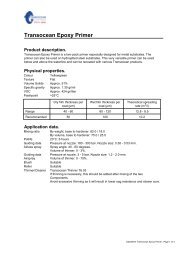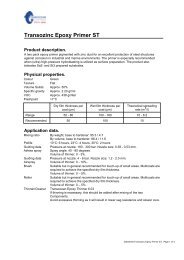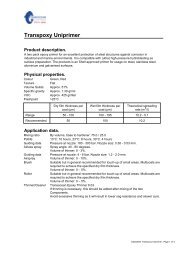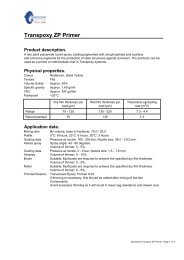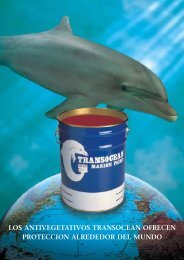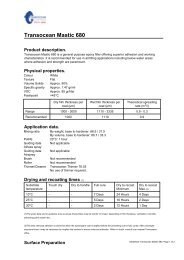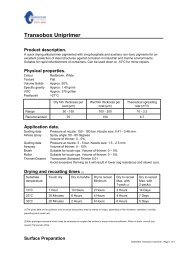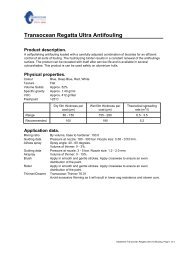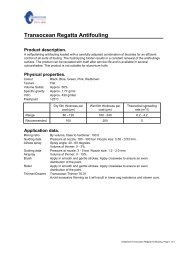Product Data Sheet Transosil Aluminium 515 - Transocean Coatings
Product Data Sheet Transosil Aluminium 515 - Transocean Coatings
Product Data Sheet Transosil Aluminium 515 - Transocean Coatings
You also want an ePaper? Increase the reach of your titles
YUMPU automatically turns print PDFs into web optimized ePapers that Google loves.
<strong>Transosil</strong> <strong>Aluminium</strong> <strong>515</strong><br />
<strong>Product</strong> description.<br />
<strong>Aluminium</strong> finish based on silicone resins for steel substrates where heat resistance up to 600 °C is<br />
required. The product can be applied on Transozinc Silicate Solventborne 1.52 if a better<br />
resistance against corrosion is desired. For maximum heat resistance <strong>Transosil</strong> <strong>Aluminium</strong> HR<br />
must be applied directly on the steel.<br />
Physical properties.<br />
Colour<br />
Silver<br />
Texture<br />
Gloss<br />
Volume Solids Approx. 40%<br />
Specific gravity Approx. 1.10 gr/ml<br />
VOC<br />
Approx. 540 gr/liter<br />
Flashpoint >25°C<br />
Dry film thickness per<br />
coat (µm)<br />
Wet film thickness per<br />
coat (µm)<br />
Theoretical spreading<br />
rate (m 2 /l)<br />
Range 20 - 40 50 - 100 20 - 10<br />
Recommended 20 50 20<br />
Application data.<br />
Guiding data<br />
Airless spray<br />
Guiding data<br />
Airspray<br />
Brush<br />
Roller<br />
Pressure at nozzle: 120 - 150 bar. Nozzle size: 0.38 - 0.43 mm.<br />
Spray angle: 40 - 80 degrees.<br />
Volume of thinner: 0 - 3%.<br />
Pressure at nozzle: 2 - 3 bar. Nozzle size: 1.5 - 2.0 mm.<br />
Volume of thinner: 0 - 10%.<br />
Suitable.<br />
Volume of thinner: 0 – 5%.<br />
Suitable.<br />
Volume of thinner: 0 – 5%.<br />
Thinner/Cleaner <strong>Transocean</strong> Standard Thinner 6.01<br />
Avoid excessive thinning as it will result in lower sag resistance and slower cure.<br />
Drying and recoating times (1)<br />
Substrate<br />
temperature<br />
Touch dry Dry to handle Full cure Dry to recoat<br />
Minimum<br />
Dry to recoat<br />
Max.(2)<br />
23°C 15 Minutes - 1 Hour 4 Hours Indefinite<br />
(1)The product dries to tack free at ambient temperature. A full cure stage will only be reached after the product has been exposed to 200°C<br />
for at least 1 hour.<br />
The given data must be considered as guidelines only. The actual drying time/times before recoating may be shorter or longer, depending on<br />
film thickness, ventilation, humidity, preceding paint system etc.<br />
(2)After prolonged exposure times it may be necessary to roughen the surface to ensure intercoat adhesion. When in doubt, consult your<br />
nearest <strong>Transocean</strong> office.<br />
Surface Preparation<br />
<strong>Data</strong>sheet <strong>Transosil</strong> <strong>Aluminium</strong> <strong>515</strong>, Page 1 of 3.
Steel - Blast Cleaning<br />
All surfaces should be clean, dry and free from contamination. Surfaces should be treated in<br />
accordance with ISO 8504:2000.<br />
All edges shall be ground to a minimum radius of 2 mm. Remove weld spatter and smooth weld<br />
seams by using disc grinders, chipping hammers or other suitable power tools. Sharp edges, weld<br />
seams, corners and other areas that are likely to receive less dry film thickness than specified,<br />
should be stripe coated.<br />
The surfaces shall be blast-cleaned to min. Sa 2½ (ISO 8501-1:2007). The surface profile and the<br />
anchor pattern shall be between 40 µm and 70 µm.<br />
The abrasives shall be free from oil, grease, moisture, chloride contamination etc.<br />
Minor repair / Touch-up<br />
All surfaces should be clean, dry and free from contamination. Surfaces should be treated in<br />
accordance with ISO 8504:2000.<br />
Any corroded areas should be prepared by power-tool cleaning or water jetting.<br />
Power-tool cleaning to min. St 2, preferably St 3 (ISO 8501-1:2007). Care shall be taken to ensure<br />
that power-tool cleaning does not polish the steel surface. If the surface being prepared lies<br />
adjacent to a coated surface, the power tool cleaning shall overlap the coated surface by at least<br />
25 mm and the coated surface shall be feathered.<br />
Water jetting in accordance to ISO 8591-4: 2006 to a cleanliness of Wa 2 or better for atmospheric<br />
exposure. Acceptable flash rust degree is M (medium) but degree L (light) is preferred.<br />
A water pressure of at least of 1000 bar (approx. 15.000 psi) is recommended.<br />
Contact your local <strong>Transocean</strong> office for more information.<br />
Major Repair/ Refurbishment<br />
All surfaces should be clean, dry and free from contamination. Surfaces should be treated in<br />
accordance with ISO 8504:2000.<br />
Corroded areas to be prepared by blast cleaning or water jetting.<br />
Blast Cleaning: The surfaces shall be blast-cleaned to min. Sa 2½ (ISO 8501-1:2007). The<br />
abrasives shall be free from oil, grease, moisture, chloride contamination etc.<br />
Water jetting: Water jetting in accordance to ISO 8591-4: 2006 to a cleanliness of Wa 2,5.<br />
Acceptable flash rust degree is M (medium) but degree L (light) is preferred.<br />
A water pressure of at least of 1000 bar (approx. 15.000 psi) is recommended.<br />
Alternatively a suitable priming system can used. When recoating zinc primed products, ensure the<br />
primer has been fully cured. Zinc salts products shall be removed by high pressure fresh water<br />
cleaning. Contact your local <strong>Transocean</strong> office for more information.<br />
Coated substrates<br />
All surfaces should be clean, dry and free from contamination. Surfaces should be treated in<br />
accordance with ISO 8504:2000.<br />
Ensure compatibility of the coated substrates with the selected paint system. If the remaining part<br />
of the existing coating system needs to be sweep-blasted, fine abrasive shall be used to avoid<br />
damage to the coating system.<br />
When recoating aged coated substrates, damaged areas must be removed back to a firm edge.<br />
Light abrade or sweep-blast the surface in order to provide a physical key for adhesion.<br />
When recoating zinc primed products, ensure the primer has been fully cured. Zinc salts products<br />
shall be removed by high pressure fresh water cleaning.<br />
Contact your local <strong>Transocean</strong> office for more information.<br />
<strong>Data</strong>sheet <strong>Transosil</strong> <strong>Aluminium</strong> <strong>515</strong>, Page 2 of 3.
Typical paint system<br />
A typical system for this product is shown below and should be taken for guidance only. A full<br />
system specification where all details are taken into consideration can be obtained through your<br />
local <strong>Transocean</strong> representative.<br />
Transozinc Silicate 152 Recommended: 75µm DFT<br />
<strong>Transosil</strong> <strong>Aluminium</strong> <strong>515</strong> Recommended: 20µm DFT<br />
<strong>Transosil</strong> <strong>Aluminium</strong> <strong>515</strong> Recommended: 20µm DFT<br />
<strong>Transosil</strong> <strong>Aluminium</strong> 516 Recommended: 20µm DFT<br />
<strong>Transosil</strong> <strong>Aluminium</strong> 516 Recommended: 20µm DFT<br />
<strong>Transosil</strong> HR Recommended: 50µm DFT<br />
<strong>Transosil</strong> HR Recommended: 50µm DFT<br />
Application conditions<br />
The temperature of the substrate should be at least 3°C above the dew point of the air.<br />
Temperature and relative humidity should be measured in the vicinity of the substrate.<br />
The maximum recommended surface temperature is approx. 40°C. Higher steel temperatures are<br />
acceptable provided dry-spray is avoided by proper spray application and extra thinning if required.<br />
In extreme cases it may be necessary to reduce film thickness in order to avoid sagging.<br />
When applying the paint in confined spaces, provide adequate ventilation during application and<br />
drying.<br />
The temperature of the mixed paint should be at least 15°C, otherwise extra solvent may be<br />
required to obtain a proper application viscosity.<br />
Storage and shelf life<br />
The product must be stored in accordance with national regulations. The cans are to be kept in a<br />
dry, cool, well ventilated space and away from source of heat and ignition. Cans must be kept<br />
tightly closed.<br />
Worldwide availability<br />
The product is part of the common <strong>Transocean</strong> product range but local availability is subject to<br />
confirmation. Although we strive to supply the same product through the world, slight modifications<br />
of the product in some cases may be necessary in order to comply with local conditions and/or<br />
national regulations. In such cases an alternative datasheet will issued.<br />
Health and safety<br />
Observe the precautionary notices on the label of the container. A material safety data sheet is<br />
available upon request and national or local safety regulations should be followed. This product is<br />
intended for use by professional applicators.<br />
As a general rule, avoid skin- and eye contact by wearing overalls, gloves, goggles, mask, etc.<br />
Spraying should be carried out under well-ventilated conditions. This product contains flammable<br />
materials and should be kept away from sparks and open flames. Smoking in the area should not<br />
be permitted.<br />
Disclaimer<br />
The information in this data sheet is provided to the best of our knowledge. However, we have no<br />
control over either quality or condition of the substrate and other factors affecting the use and<br />
application of this product. Therefore, we cannot accept any liability whatsoever or howsoever<br />
arising from the performance of the product or for any loss or damage arising from the use of this<br />
product. We reserve the right to change the product without notice.<br />
MID Number: <strong>515</strong>-1002<br />
Date of issue: May 2014<br />
<strong>Data</strong>sheet <strong>Transosil</strong> <strong>Aluminium</strong> <strong>515</strong>, Page 3 of 3.



